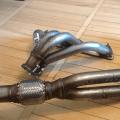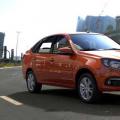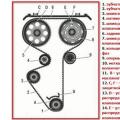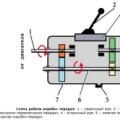Ford focus 2 has established itself as a reliable, durable car that withstands many strength tests. But nothing is eternal, and even such powerful mechanisms eventually need correction, and sometimes even repair. The rear suspension of the Ford Focus 2 is not the weakest link in the design, but it is this part of the car that is difficult to repair, which means that a little more attention should be paid to its diagnosis.
Rear suspension device Ford Focus 2
The second generation Ford Focus rear suspension is an independent, multi-link mechanism. It is more complicated than the front axle, so the repair rear suspension usually costs a pretty penny.
The rear suspension consists of:
- stamped trailing arms
- hydraulic shock absorber
- stretcher
- lower front and rear levers
- stabilizer
- upper arm
- springs
- adjusting bolts
- silent blocks
- brake shields
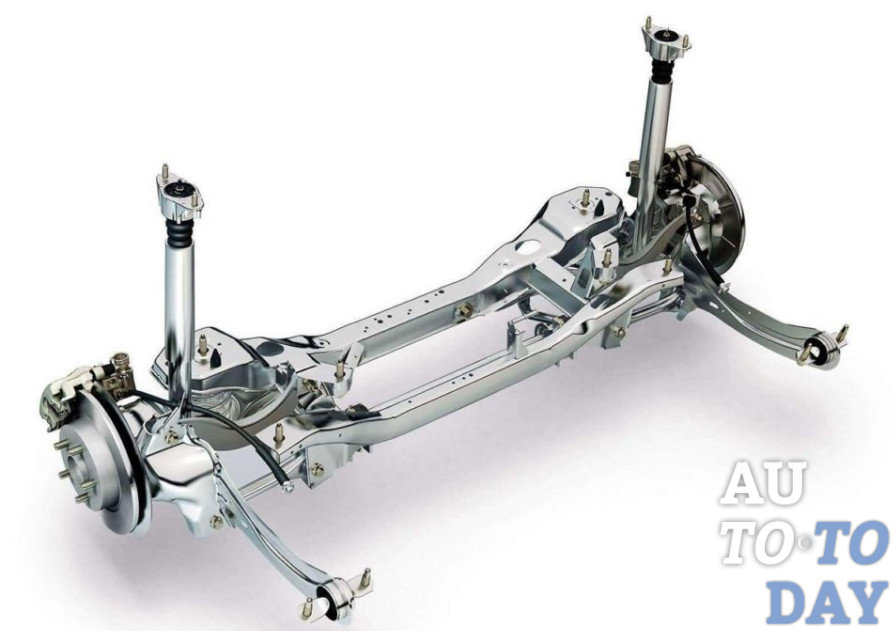 Despite the large number of details, the design of the rear suspension Ford Focus 2 is quite simple. The supporting parts of the suspension (stamped trailing arms) are connected to the subframe by three wishbones. The longitudinal levers take over the braking force, and the transverse levers take over obstacles. The trailing arms are attached to the body with two bolts, between which there is a silent block. With his help, the wishbones are also attached.
Despite the large number of details, the design of the rear suspension Ford Focus 2 is quite simple. The supporting parts of the suspension (stamped trailing arms) are connected to the subframe by three wishbones. The longitudinal levers take over the braking force, and the transverse levers take over obstacles. The trailing arms are attached to the body with two bolts, between which there is a silent block. With his help, the wishbones are also attached. Important! Rear suspension Ford Focus 2 has 8 levers and 14 silent blocks.
The hub assembly is attached to the rear of the trailing arm. This part consists of three parts (bearing, hub, wheel speed sensor). There are springs between the lower arms and the subframe, for which special support cups are made.
Springs and shock absorbers allow you to overcome obstacles by adjusting the height level rear wheels... Driving over irregularities, the wheel goes into "floating mode", rising up and down, thereby smoothing out abrupt transitions.
And the last element of the Ford Focus 2 rear suspension device is stabilizer lateral stability. It not only increases the stability of the entire vehicle, helps the vehicle balance on bumpy roads, but also balances the vehicle when cornering.
Interesting! In 2008 ford model The Focus 2 underwent a restyling that affected all parts of the car except for the rear suspension.
How to determine the condition of a car's suspension
It is worth emphasizing again that the suspension is one of the most important elements of a car, which carries a large load, which the suspension does not always cope with.
Diagnostics of the rear suspension Ford Focus 2 consists of one-by-one check of the operability of each of its parts. And the first thing to start with is:
Checking wheels
Sometimes, in order to understand whether there is a problem in the operation of internal mechanisms, it is not necessary to climb under the hood or in inspection pit. The condition of the wheels and their attachment points can indicate a malfunction of the rear suspension. Loose wheels, worn parts at the joints and attachments will be a serious excuse for a deeper diagnosis of the suspension.
Ball joint check
The wear of this suspension part can cause damage to the entire rear suspension of the Ford Focus 2. In order to spherical bearing out of order, it is not at all necessary to drive through pits and bumps, it is enough just not to notice that the part has become unusable.
 Signs of wear on ball joints:
Signs of wear on ball joints:
- Knocking noise when driving on uneven surfaces even at minimum speed
- Unevenly worn rubber on the tire
- Creak while turning
- The car "leads" a little to the side when driving in a straight line
Interesting fact! Speaking about the durability of suspension parts, it is relatively car ford Focus of the second generation, there are statistics: silent blocks withstand from 80 to 110 thousand km of run; shock absorbers - 130 thousand km; stabilizer struts - 150 thousand km
Stabilizer pivots
According to the Ford Focus 2 rear suspension scheme, the stabilizer bar joints are the suspension element that connects it to the car body. From this we can conclude how serious the consequences of wear of the hinges can be.
 Irregularities, holes, bumps, bumps and sharp turns put a heavy load on the rear suspension of the car. But it is the stabilizers that suffer the most from weight strength. It is possible to determine the serviceability of the stabilizer hinges by turning the wheels as much as possible to the side, then find the stand by touch and pull it. If the rack gives in (moves, squeaks, knocks), then this indicates a malfunction of the part. Oil leaks, cracked hinges, and dirty parts can all cause hinge failure.
Irregularities, holes, bumps, bumps and sharp turns put a heavy load on the rear suspension of the car. But it is the stabilizers that suffer the most from weight strength. It is possible to determine the serviceability of the stabilizer hinges by turning the wheels as much as possible to the side, then find the stand by touch and pull it. If the rack gives in (moves, squeaks, knocks), then this indicates a malfunction of the part. Oil leaks, cracked hinges, and dirty parts can all cause hinge failure.
Checking shock absorbers
The deterioration of the rear suspension Ford Focus 2 strongly affects the "behavior" of the car. And if the problems of other parts can only be suspected by individual signs, then the driver will find out about the wear of the shock absorber almost immediately and unmistakably.
The car starts to rock like a roller coaster, even with a slight rocking of the car. As soon as the driver and passengers of the car begin to feel every pebble on the road, this indicates that it is time to start repairing shock absorbers.
 Car manufacturers have set certain settings for the camber and toe angle of the Ford Focus 2. According to the regulations, the nominal value of the camber in the Ford Focus 2 is "-1 ° 17" ", and the toe-in is" 0 ° 23 "± 0 ° 09". Permissible limits of camber angles are from 0 ° 00 "to 2 ° 35", and toe-in 0 ° 14 "to 0 ° 32". At the same time, camber values \u200b\u200bof 1 ° 17, and 0 ° toe are the maximum difference between the wheel angles. Exceeding this norm is a serious reason for deep diagnosis.
Car manufacturers have set certain settings for the camber and toe angle of the Ford Focus 2. According to the regulations, the nominal value of the camber in the Ford Focus 2 is "-1 ° 17" ", and the toe-in is" 0 ° 23 "± 0 ° 09". Permissible limits of camber angles are from 0 ° 00 "to 2 ° 35", and toe-in 0 ° 14 "to 0 ° 32". At the same time, camber values \u200b\u200bof 1 ° 17, and 0 ° toe are the maximum difference between the wheel angles. Exceeding this norm is a serious reason for deep diagnosis.
Remember! You can adjust the camber angle by using the adjusting bolts that connect the subframe and the rear suspension arms.
How to maximize the life of your Ford Focus 2 suspension, tips
The active operation of the car inevitably leads to wear and tear of its individual parts. But some simple tips can help extend the life of your vehicle's suspension.
- Perform in-depth diagnostics of suspension parts every 200 thousand km, regardless of whether there is a malfunction in the vehicle or not.
- Uneven, unpaved roads loosen the shock absorbers and suspension fittings. Try to avoid such roads.
- If you notice a malfunction in the machine (the appearance of knocks, squeaks, rocking), immediately contact the service station.
- Carry out inspection and repair of cars in specialized centers.
- Give preference to factory parts and lubricating fluids.
Subscribe to our feeds in
The rear suspension, installed on the second generation Ford Focus, has a multi-link design, due to this, a smooth ride of the car and confident behavior of the car on the road are achieved.
But the multi-link system has not only advantages, but also disadvantages - when mechanical damage more parts have to be changed, and the undercarriage repair itself is not cheap. In this article, we will look at what the rear suspension Ford Focus 2 is: a diagram, repair, what are the characteristic "diseases" of the chassis, how to replace the rear shock absorber and stabilizer bar.
Rear suspension Ford Focus-2 - independent type, with a cross member in the middle, with four levers each rear wheel (total levers - 8). The undercarriage consists of the following elements:
- crossbars;
- levers - rear lower, upper, front lower, longitudinal;
- springs;
- shock absorbers;
- compression buffers.
All elements, except for the cross beam, are paired, and an anti-roll bar with struts and bushings is also installed on the rear axle. 
The Ford Focus-2 was produced in two body modifications - in a pre-styling version (2005-2008) and in a restyled version (2008-2011). After the modernization, there were some changes in the car, but the restyling did not touch the rear suspension - it remained the same.
In the domestic market, the vast majority of Ford Focus-2 are found only russian assembly, therefore, it is difficult to speak about the quality of spare parts installed on cars assembled in Spain and Germany. But the cars assembled in Vsevolozhsk near St. Petersburg are quite reliable, and the rear suspension lasts a long time during normal operation.
If you do not drive a car high speed on bad roads, more or less serious repairs chassis will require about 100 thousand km on the run, not earlier. As a rule, the longitudinal levers fail first, the silent blocks wear out in them. The lever can not be completely changed, you can do with repressing the silent blocks, but in order to make such a repair, it is necessary to disassemble almost the entire suspension. 
The rear shock absorbers on the "Second Focus" are distinguished by enviable "vitality", on average, the parts are nursed from 90 to 130 thousand km. Price original spare parts rather big, each shock absorber costs about 3.5 thousand rubles. But fortunately, on the Focus-2 there are parts of non-original production, moreover, of very decent quality. For example, Monroe or Kayaba shock absorbers can be purchased at a price of 2-2.5 thousand rubles. for 1 piece, and TRW spare parts are even cheaper. Also, these parts are produced by many other companies:
- Bilstein;
- SACHS;
- Koni et al.
The stabilizer struts are usually the first to fail on many car models, but on the Ford Focus 2 these parts are surprisingly tenacious, sometimes nursing more than 100 thousand km. 
Car owners of "Second Focuses" need to know that many spare parts for the car are suitable from Mazda 3, in particular, many of the rear suspension parts are practically the same. True, there is one difference - native Ford spare parts are more reliable than Mazda parts, although they are more expensive.
If in the area of \u200b\u200bthe stem rear shock absorber oil stains appeared, and the car began to drive over bumps with the rear part of the body swaying, the shock absorber was out of order, and it must be changed. We carry out the work as follows:

Replacing the rear stabilizer bar
If there is a knock around the rear suspension, it is likely that the stabilizer struts are worn out. Parts are changed quite simply, if there are no complications during removal, you can replace the stabilizer rack in half an hour or even faster.
It is convenient to replace it on a pit or on a lift; you do not need to remove the wheel to perform the operation. We carry out the work in the following order:

Everything was simple, but the old counter does not always turn away normally. The thread on the ball pin is clogged with dirt, and when you try to unscrew the nut, the hex wrench turns in the body of the pin. Before starting to untwist the connection, you must:
- clean the threads on the stabilizer post from dirt;
- sprinkle WD40 on it;
- wait 15-20 minutes for the remaining dirt to "eat off".
Only then should you start loosening the nuts. If, nevertheless, the ball pin scrolls in the body, and the nut rotates with it, you will have to use a small grinder - cut off the worn out stabilizer bar.
In this case, the replacement of the L-shaped stabilizer struts is considered, but stabilizer struts of the so-called "direct" type can also be installed on the Ford Focus-2. 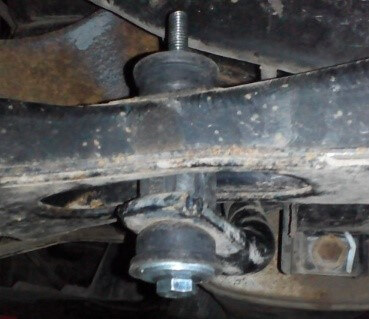
These details change even more easily, there are practically no complications here.
Replacing the rear suspension ford focus 2: video
Menu 1.Operating manual 2.Engine 3.Clutch 4.Gearbox 5.Front wheel drive 6.Front suspension 7.Rear suspension 8.Steering 9.Brake system 10.Electrical equipment 11.Body 12.Heating, ventilation and air conditioning 13 .Applications Forum Technical assistance "FORD"

Rear suspension: 1- trailing arm; 2 - shock absorber; 3 - stretcher; 4 5 6 - lower rear arm; 7 - spring; 8 - brake shield; 9 - upper arm; 10 - lower front arm; 11 - silent block of the trailing arm

Rear suspension elements on the car: 1- silent block of the trailing arm; 2 - trailing arm; 3 - lower front arm; 4 - upper arm; 5 - shock absorber; 6 - spring; 7 - stretcher; 8 — adjusting bolt (the bolt securing the rear lower arm to the subframe); 9 - anti-roll bar; 10 - lower rear arm; 11 - brake shield
The rear suspension is independent, multi-link, with coil springs and double-acting hydraulic shock absorbers.
The main bearing elements of the suspension are stamped trailing arms, each of which is connected to the subframe by three wishbones through silent blocks.
The braking forces when the car is moving are perceived by the trailing arms, and the forces in the direction perpendicular to the longitudinal axis of the car are perceived by the wishbones.

Trailing arm
A silent block is installed in the front of the trailing arm, through which the arm is fixed with two bolts to the body. The rear wheel hub assembly is attached to the rear of the arm with four screws.

Rear wheel hub assembly: 1 - rear wheel hub; 2 - wheel speed sensor
The hub unit is a non-separable unit with a bearing and a driving element of the wheel speed sensor anti-lock braking system brakes.

Lower rear arm
Spring support cups are made in the lower rear levers. The upper ends of the springs abut against the subframe cups. The cups are fitted with rubber pads.
The lower shock absorber eye is bolted to the trailing arm, and the upper shock absorber mount is bolted to the body.
Shock absorbers and rear suspension springs allow the rear wheels to move up and down when driving over bumps and at the same time dampen body vibrations.

Anti-roll bar parts: 1 - bottom cushion with a bolt; 2 - buffer; 3 - top pillow; 4 - nut with washer; 5 - barbell; 6 - pillow; 7 - bracket
To increase lateral stability and reduce the roll angles of the car, an anti-roll bar is installed. The stabilizer bar in its middle part is attached with two brackets through rubber split pads to the subframe. The ends of the stabilizer bar are connected to the rear lower arms through struts with rubber-metal hinges.

Upper arm

Lower front arm

The toe angles of the rear wheels are adjusted by rotating the bolts securing the lower rear levers to the subframe (adjusting bolts).
The adjusting bolt has an eccentric head and a washer. When the bolt with a washer rotates, its position in the subframe hole changes: when the bolt is displaced to the longitudinal axis of the car, the outreach of the lower rear arm and, consequently, the wheel toe angle decreases; when the bolt is displaced from the axis, the angle increases.
The front suspension of the Ford Focus 2 is lever-spring, independent, MacPherson type. Consists of a subframe, a steering knuckle with a hub, a lever with a ball joint and silent blocks, a shock absorber strut and an anti-roll bar with a strut.
Most of the elements of the front suspension structure are designed for about 100 thousand kilometers without repair, except for the hub bearing, which must be changed after 50-60 thousand kilometers. In this case, the hub bearing, the hub itself and rounded fist are not disassembled and the entire node is changed. Due to the unsatisfactory state of the roads in our country, the front suspension mileage is halved. After every 20 thousand kilometers of run or impact while driving through especially deep holes on high speed it is necessary to check the condition of the front suspension. The problem that most often arises with the front suspension of the Ford Focus 2 is the noise effect (knock) when driving through bumps.
Preliminary diagnosis of front suspension malfunctions
Shock absorbers
- The function of the shock absorber is to damp the vibrations of the spring. If, when you press on one side of the machine, it returns to its original position and there are no repeated vibrations, the shock absorber is working.
- We take up the wheel and swing towards ourselves and away from ourselves. If we feel a backlash, then the shock absorber is faulty. If, after pressing the brake, the play disappears, it is very likely that it is time to change the front hub bearing.
- When visually inspecting the bottom of the shock absorber, there should be no damage and oil drips and the springs should be intact.
Steering rods
It is best to check when the machine is raised.
We swing the wheel left - right. If play is felt, then the ball joint, steering tip or linkage is faulty.
Anti-roll bar joints
- No external damage to the ball joint covers.
- Move the stabilizer bar up and down by hand or with a pry bar. If we feel a backlash, then the racks need to be changed.
Rear bushing to subframe
- Visually, there should be no delamination of the rubber.
- We are trying to move the ear of the lever by inserting a screwdriver between it and the assistant. If it moves, then the silent block needs to be changed.
Ball bearings
We take a screwdriver, carefully insert it between the lever and the steering knuckle. We move up and down. If there is a backlash or knock, it is necessary to change the ball.
After completing the preliminary diagnostics, it is advisable to go to the service station and make sure that your conclusions are correct. In most cases, the problem will be in the hub bearing or one part of the arm.
Repair schemes for the two most common problems with the front suspension Ford Focus 2
Front hub bearing replacement diagram
 It is advisable to change both bearings at the same time.
It is advisable to change both bearings at the same time.
- We jack up the car, unscrew the hub bolt, unscrew and remove the wheel.
- In order not to damage, release the anti-roll bar.
- Disconnect the terminal aBS sensor (anti-lock braking system).
- We release the tip of the tie rod.
- We shoot stopping support... Hose brake system do not disconnect. We fix the brake caliper so as not to damage the hose. We shoot down the brake disc.
- We unscrew the ball fastening nut and press it out with a puller or knock a finger out of the lever with a hammer. Please note that in no case should you hit the ball, we hit the bottom of the steering knuckle.
- We unscrew the bolt of the terminal connection of the shock absorber and the steering knuckle. Using a chisel and a hammer, unclench the terminal connection and release the shock absorber strut.
- We remove the steering knuckle by pulling out the hinge of equal angular velocities front wheel drive.
- The ABS sensor can be pulled out if you are afraid of damage. The bearing is equipped with a red seal. When changing bearings, buy the same. The fact is that the wheel rotation sensor ring is combined with the bearing, and if there is a bearing without this red seal, the ABS will not work.
- Using a puller, we press out the hub together with the bearing and press in a new one.
- We collect everything and go to do wheel alignment.
The second problem that often occurs in Ford Focus 2 is the failure of the elements of the front suspension arm: the rear mount silent block or ball. The ball joint is quite simple to change, and the silent block is not removable, and if it fails, then most often, due to the absence special tools for repair, the entire front suspension arm is replaced.

